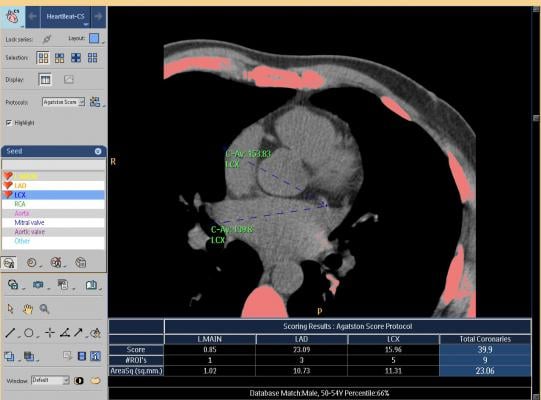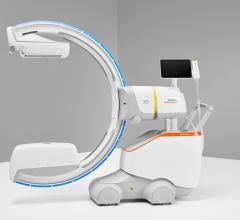
March 9, 2016 — New research suggests a high coronary artery calcium score puts people at greater risk not only for heart and vascular disease but also for cancer, chronic kidney disease and chronic obstructive pulmonary disease (COPD). The research was part of a 10-year follow-up study of more than 6,000 people who underwent heart computed tomography (CT) scans.
A report on the study, conducted by researchers at the Johns Hopkins University School of Medicine and elsewhere, is published online on March 9 in the Journal of the American College of Cardiology: Cardiovascular Imaging.
“Plaque in the arteries is the result of cumulative damage and inflammation, and vulnerability to injury and chronic inflammation likely contributes to diseases like cancer, kidney and lung diseases, as well as cardiovascular disease. So it makes sense that the coronary calcium score — a measure of arterial aging — is predictive of noncardiovascular diseases too,” said Michael Blaha, M.D., MPH, director of clinical research for the Ciccarone Center for the Prevention of Heart Disease and assistant professor of medicine at the Johns Hopkins University School of Medicine. “The reason the coronary calcium score may work so well at identifying vulnerability to a variety of chronic diseases is because it’s a direct measurement of the cumulative effect of all risk factors, rather than a consideration of a single risk factor, like obesity, smoking or high blood pressure.”
Blaha and his colleagues caution, however, that theirs was an “association study” that didn’t look for, measure or find a cause-and-effect relationship between coronary calcium levels and noncardiovascular diseases.
Heart CT scans quickly and automatically measure how much and how dense the levels of the mineral are in the blood vessels that nourish the heart’s arteries. Coronary artery calcium is a well-known predictor of coronary heart disease and stroke risk. The risk of these diseases is low when the calcium score is zero, and that risk balloons nearly fivefold when the score is above 400. For the current study, the research team, composed of investigators from Johns Hopkins; the University of California, Los Angeles; Henry Ford Hospital in Detroit; the Minneapolis Heart Institute; and Columbia University, used data from six centers that contributed subjects to the Multi-Ethnic Study of Atherosclerosis, or MESA.
The 6,814 participants were of white, African-American, Hispanic and Chinese descent, ages 45 to 84, and free of cardiovascular disease at the time of an initial heart CT scan and coronary calcium score calculation.
Over 10 years, until 2012, participants underwent follow-up visits at least once a year to review new diagnoses through hospital and death records.
After 10 years, of the 6,814 original participants, 1,238 were diagnosed with a noncardiovascular disease, including prostate, lung, gastrointestinal/colon, breast, skin, blood and uterine/ovarian cancers; kidney disease; pneumonia; a blood clot; lung disease; dementia; and hip fracture. Of those participants with coronary calcium scores over 400, 36.9 percent of participants were diagnosed with a noncardiovascular disease, compared to 11 percent of participants with no coronary artery calcium.
Of the 710 new cancer diagnoses, over two-thirds (68 percent) occurred in participants with detectable calcium in their coronary arteries. According to the investigators, after adjusting for other factors, individuals with the highest calcium scores greater than 400 had a 53 percent increased risk of developing cancer during follow-up.
Chronic kidney disease was diagnosed in 395 participants, with the incidence ranging from just 3 percent in participants with zero coronary calcium to over 13 percent in those with scores over 400. After adjusting for other factors, a person with a high coronary calcium score was 70 percent more likely to develop future kidney disease.
At the completion of the study, 161 participants were diagnosed with COPD. Those people with high coronary calcium scores over 400 were 2.7 times more likely to have COPD than those with no detectable calcium.
The researchers reported borderline associations between coronary artery calcium scores and dementia and hip fracture, and no association with blood clots or pneumonia after controlling for age, sex, race, income and health insurance status. The data for dementia and hip fractures are considered promising but may be inconclusive due to too few participants diagnosed with each disease.
The researchers also caution that because hospital record billing codes were used to determine the diagnoses they used in their study, milder cases of disease not requiring hospitalization could have been overlooked. However, this would have made it less likely to see the associations found in this study.
Blaha and his team also published an analysis of MESA participant data last year that shed light on the biology of “healthy agers” with persistent coronary calcium scores of zero after 10 years of scanning. These people appear to have protection from both heart disease and noncardiovascular diseases. Those results were published in the December 2015 issue of the Journal of the American College of Cardiology: Cardiovascular Imaging.
Other authors on the study include Catherine Handy, Chintan Desai, Zeina Dardari, Pamela Ouyang, Roger Blumenthal and Khurram Nasir of Johns Hopkins Medicine; Mouaz Al-Mallah of Henry Ford Hospital; Michael Miedema of the Minneapolis Heart Institute; and Matthew Budoff of the University of California, Los Angeles.
This study was funded by grants from the National Heart, Lung, and Blood Institute.
For more information: www.imaging.onlinejacc.org


 April 17, 2024
April 17, 2024 








